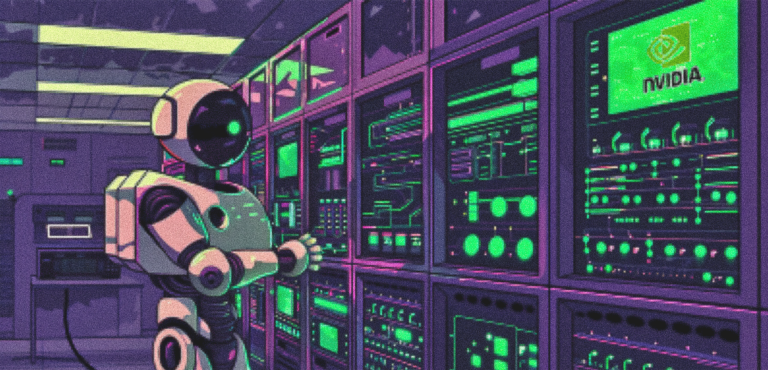
Inside the NVIDIA Supercomputer Project Digits
At CES in January 2025, NVIDIA unveiled Project DIGITS, a compact yet powerful AI supercomputer priced at $3,000 (£2,400). Designed for AI developers, researchers, and students, this machine brings advanced AI capabilities to the desktop. It makes high-performance computing more accessible.
Expensive, large-scale server clusters have traditionally constrained AI development. However, with Project DIGITS, NVIDIA aims to bridge this gap by providing a system that runs on a relative of the Grace Blackwell graphics processing units. The same architecture powers the world’s most advanced AI clusters.
A mini supercomputer with big power
The highlight of NVIDIA supercomputer Project DIGITS is its GB10 Grace Blackwell Superchip. It combines an advanced Blackwell GPU with NVIDIA’s Grace CPU in a compact, power-efficient package. This system-on-a-chip (SoC) delivers 1 petaflop of AI performance at FP4 precision. It is ideal for AI model training, inference, and data science applications. The 20-core Arm-based CPU ensures seamless performance. NVLink-C2C connectivity between the CPU and GPU improves efficiency and data transfer speeds.
Unlike traditional AI servers that need complex cooling and high-power setups, Project DIGITS runs on a standard electrical outlet. It compares to high-end desktop AI workstations like NVIDIA’s RTX-powered systems. However, its integration of a Blackwell GPU and Grace CPU sets it apart, delivering data-centre-level performance in a compact form factor. This makes it an attractive choice for individuals and organisations that want powerful AI capabilities without the infrastructure costs of a full-scale data centre.
The NVIDIA supercomputer designed for AI developers
Project DIGITS is tailored to meet the demanding needs of AI professionals and researchers. With 128GB of unified memory and up to 4TB of NVMe storage, it can handle large-scale AI models with up to 200 billion parameters. For even more demanding applications, two Project DIGITS systems can be connected via NVIDIA ConnectX networking, enabling support for models with up to 405 billion parameters.
The machine also runs on NVIDIA DGX OS, a Linux-based operating system optimised for AI workloads. This ensures seamless compatibility with the NVIDIA AI ecosystem. It allows developers to train, test, and fine-tune models locally before deploying them on cloud-based NVIDIA DGX servers or enterprise-scale AI infrastructure.
AI software and frameworks at your fingertips
Developers using Project DIGITS gain access to NVIDIA’s full AI software suite, including:
- NVIDIA NeMo – A framework for training and fine-tuning large language models.
- NVIDIA RAPIDS – Accelerated libraries for data science and machine learning workflows.
- Support for PyTorch, TensorFlow, and Jupyter Notebooks – Ensuring flexibility in AI development.
- NVIDIA NGC Catalog – A hub for pre-trained models, frameworks, and AI toolkits.
This rich software ecosystem ensures developers can seamlessly integrate Project DIGITS into existing AI workflows, reducing setup time and increasing productivity.
Seamless transition from development to deployment
One of the standout features of NVIDIA supercomputer Project DIGITS is its scalability and interoperability. Developers can build and test models locally and then deploy them on NVIDIA DGX Cloud, enterprise data centres, or other NVIDIA-powered platforms. This ensures a smooth transition from prototype to production, reducing deployment complexities.
Companies developing AI applications on a smaller budget will find this valuable. It removes the need for costly upfront infrastructure investments.
A game-changer for AI research and education
With AI becoming a cornerstone of research and development across industries, access to high-performance computing has been a barrier for many universities, independent researchers, and smaller companies. Project DIGITS changes that.
Universities and students – An affordable AI development platform for research and coursework.
Startups and independent researchers – A powerful yet compact alternative to expensive cloud-based AI computing.
Enterprises – Enables faster prototyping before scaling AI solutions to larger NVIDIA-powered infrastructures.
Jensen Huang, NVIDIA’s CEO, highlighted the importance of making AI supercomputing accessible to everyone. He stressed that enabling data scientists, AI researchers, and students to have powerful AI tools at their desks would help drive innovation and shape the future of AI.
Powering the next generation of AI applications
Project DIGITS is poised to fuel innovation across multiple fields:
- Natural Language Processing (NLP) – Developers can train advanced chatbots and voice assistants on desktops.
- Computer Vision – AI models for medical imaging, facial recognition, and autonomous navigation can be refined without large-scale clusters.
- Scientific Research – Researchers can process vast genomics, climate modelling, and materials science datasets.
- Robotics and Automation – AI-driven robotics applications can be tested and optimised in real-world environments.
With compact and affordable high-performance AI computing, more researchers and developers can refine AI models without relying on large-scale data centres.
Availability and pricing
NVIDIA supercomputer Project DIGITS will be available from May 2025. It starts at $3,000 (£2,400). The company is working with select partners for global distribution. Developers can sign up for notifications to stay updated.
Those eager to explore its capabilities can see it at NVIDIA’s AI Developer Conference. The event will feature hands-on demonstrations and deep-dive technical sessions.
Distilled
NVIDIA has led AI innovation for years. Project DIGITS reinforces its commitment to democratising AI computing. It delivers a powerful, scalable, and affordable AI supercomputer. Developers, researchers, and students can now access cutting-edge technology.
Project DIGITS is a major leap forward. It enables large AI model training, scientific research, and AI exploration. This could redefine AI development for years to come.